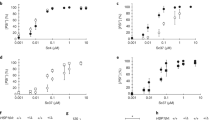Abstract
The [PSI+] factor of Saccharomyces cerevisiae is a protein-based genetic element (prion) comprised of a heritable altered conformation of the cytosolic translation termination factor Sup35p. In vitro, the prion-determining region (NM) of Sup35p undergoes conformational conversion from a highly flexible soluble state to structured amyloid fibers, with a rate that is greatly accelerated by preformed NM fiber nuclei. Nucleated conformational conversion is the molecular basis of the genetic inheritance of [PSI+] and provides a new model for studying amyloidogenesis. Here we investigate the importance of structure and structural flexibility in soluble NM. Elevated temperatures, chemical chaperones and certain mutations in NM increase or change its structural content and inhibit or enhance nucleated conformational conversion. We propose that the structural flexibility of NM is particularly suited to allowing heritable protein-based changes in cellular behavior.





Similar content being viewed by others
References
Patino, M.M., Liu, J.J., Glover, J.R. & Lindquist, S.L. Science 273, 622–626 (1996).
Paushkin, S.V., Kushnirov, V.V., Smirnov, V.N. & Ter-Avanesyan, M.D. EMBO J. 15, 3127–3134 (1996).
Stansfield, I. et al. EMBO J. 14, 4365–4373 (1995).
Wickner, R.B. Science 264, 566–569 (1994).
Serio, T.R. & Lindquist, S.L. Annu. Rev. Cell Dev. Biol. 15, 661–703 (1999).
Prusiner, S.B. & Scott, M.R. Annu. Rev. Genet. 31, 139–175 (1997).
Glover, J.R. et al. Cell 89, 811–819 (1997).
Serio, T.R. et al. Science 289, 1317–1321 (2000).
DePace, A.H., Santoso, A., Hillner, P. & Weissman, J.S. Cell 93, 1241–1252 (1998).
Klunk, W.E., Jacob, R.F. & Mason, R.P. Methods Enzymol. 309, 285–305 (1999).
Esler, W.P. et al. J. Struct. Biol. 130, 174–183 (2000).
Dobson, C.M. Trends Biochem. Sci. 24, 329–332 (1999).
Kelly, J.W. Curr. Opin. Struct. Biol. 8, 101–106 (1998).
Pain, R.H. Symp. Soc. Exp. Biol. 41, 21–33 (1987).
Zhang, S. & Rich, A. Proc. Natl. Acad. Sci. USA 94, 23–28 (1997).
Kayed, R. et al. J. Mol. Biol. 287, 781–796 (1999).
Gursky, O. & Aleshkov, S. Biochim. Biophys. Acta. 1476, 93–102 (2000).
Ramirez-Alvarado, M., Merkel, J.S. & Regan, L. Proc. Natl. Acad. Sci. USA 97, 8979–8984 (2000).
Yang, D.S., Yip, C.M., Huang, T.H., Chakrabartty, A. & Fraser, P.E. J. Biol. Chem. 274, 32970–32974 (1999).
Tuite, M.F., Mundy, C.R. & Cox, B.S. Genetics 98, 691–711 (1981).
Singer, M.A., Lindquist, S.L. Mol. Cell 1, 639–648 (1998).
Liu, J.J. & Lindquist, S.L. Nature 400, 573–576 (1999).
Wong, C. et al. EMBO J. 20, 377–386 (2001).
Kocisko, D.A. et al. Proc. Natl. Acad. Sci. USA 92, 3923–3927 (1995).
Tatzelt, J., Prusiner, S.B. & Welch, W.J. EMBO J. 15, 6363–6373 (1996).
Eaglestone, S.S., Cox, B.S. & Tuite, M.F. EMBO J. 18, 1974–1981 (1999).
True, H. & Lindquist, S.L. Nature 407, 477–485 (2000).
Ter-Avanesyan, M.D. et al. Mol. Microbiol. 7, 683–692 (1993).
Scheibel, T., Kowal, A, Bloom, J. & Lindquist, S.L. Curr. Biol. 11, 366–369 (2001).
Gill, S.C. & von Hippel, P.H. Anal. Biochem. 182, 319–326 (1989).
Acknowledgements
This research was supported by the National Institutes of Health, the Howard Hughes Medical Institute, the Keck Foundation, the University of Chicago Materials Research Science and Engineering Center and a postdoctoral fellowship of the Deutsche Forschungsgemeinschaft (T.S.). We gratefully acknowledge A. Kowal for Electron Microscopy, G. Sawicki for Atomic Force Microscopy, J.-J. Liu and H.-C. Chang for sharing unpublished results, J. Frederikson and J. Rehm for experimental help, and J. Bloom, M. Duennwald, T.F. Outeiro and H. True-Knob for comments on the manuscript.
Author information
Authors and Affiliations
Corresponding author
Rights and permissions
About this article
Cite this article
Scheibel, T., Lindquist, S. The role of conformational flexibility in prion propagation and maintenance for Sup35p. Nat Struct Mol Biol 8, 958–962 (2001). https://doi.org/10.1038/nsb1101-958
Received:
Accepted:
Issue Date:
DOI: https://doi.org/10.1038/nsb1101-958
- Springer Nature America, Inc.
This article is cited by
-
A generic approach to study the kinetics of liquid–liquid phase separation under near-native conditions
Communications Biology (2021)
-
Gene expression analysis distinguishes tissue-specific and gender-related functions among adult Ascaris suum tissues
Molecular Genetics and Genomics (2013)
-
Preparation of true solutions of monomeric amyloidogenic protein/peptide: A critical prerequisite for aggregation kinetic study
Science China Chemistry (2012)
-
Self-assembly and alignment of semiconductor nanoparticles on cellulose nanocrystals
Journal of Materials Science (2011)
-
Differences in prion strain conformations result from non-native interactions in a nucleus
Nature Chemical Biology (2010)





